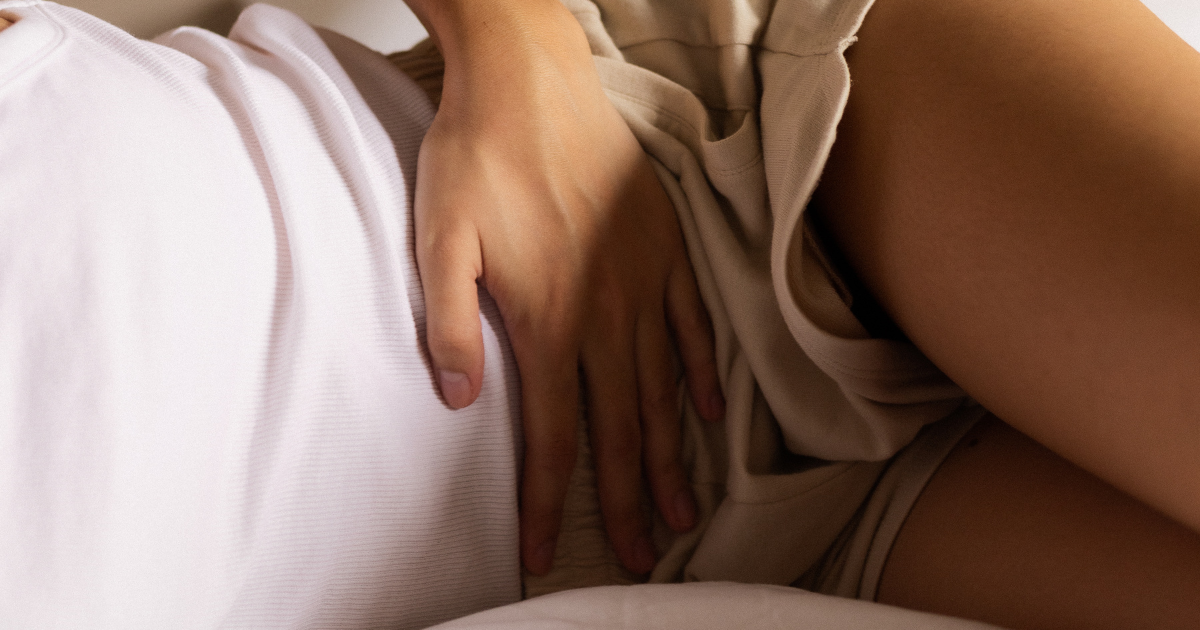5 Ways to Get Relief From Your Menstrual Cycle Symptoms (Hint: Orgasms Are One!)

Cramps. Fatigue. Irritability. Whether it’s PMS leading up to your period or symptoms during your period — you don’t need to suffer. Just because you menstruate doesn’t mean that you have to be in pain and discomfort every month. There are four phases of the menstrual cycle: menstruation, follicular phase, ovulation, and luteal phase. Today, we’re going to talk about what these phases are, how long they last, why, and ways to ease the symptoms you may experience.
Important note: Oral contraceptives, aka birth control pills, prevent your body from creating the hormones involved in the ovulation and menstruation parts of the menstrual cycle. So, this info is probably different if you’re taking oral contraceptives. However, regardless of if you’re on the pill or not, if you experience any of the symptoms we discuss, you’ll probably benefit from the solutions discussed too.
Phase 1: Menstrual Phase
This is the first stage of the menstrual cycle and it’s typically when you get your period. This phase starts when pregnancy hasn’t taken place and estrogen and progesterone levels drop and triggers the shedding of the uterine lining. During this phase, some people experience cramps, tender breasts, bloating, mood swings, irritability, headaches, lower back pain and tiredness.
What can you do to help ease these symptoms during this phase? First and foremost, it’s important to mention that while these symptoms are considered “normal,” you’re not supposed to be in debilitating pain or even significant discomfort. If you try to ease your symptoms and are still feeling pain or discomfort, please go to your doctor.
There are 5 primary at home remedies recommended for menstrual cramps:
1. Over the Counter Medication
You can try acetaminophen (Tylenol) or an NSAID (nonsteroidal anti-inflammatory drug) like Advil or Aleve.
2. Heat
A 2018 review of studies found that applying a heating pad or a heating patch was as effective as taking an over the counter pain reliever and causes fewer side effects. Pretty cool, huh? I recommend using a hot water bottle or heating pad — or if you prefer, take a warm bath!
3. Essential Oils & Massage
In another review of studies in 2018, researchers found that a combination of massaging certain points around the abdomen, side, and back with lavender, peppermint, rose, and/or fennel essential oil(s) for about 20 minutes can help relieve some of the pain and discomfort from cramps. Oh, and be sure to use what’s called a carrier oil — like coconut, grape seed, or almond oil to massage in the essential oils.
4. Sex / Orgasms
Having sex, and specifically having an orgasm, releases neurotransmitters like endorphins and oxytocin, which decrease the brain’s perception of pain. Also, some researchers believe that the uterine contractions during orgasm help relieve cramps themselves. (Figure out what kinds of orgasms give you the best relief — try a Zumio for clitoral and penetrative sex or the Fun Factory Tiger for internal).
5. Avoiding Certain Foods & Adding Other Foods & Herbs
Fatty foods, alcohol, sugar, carbonated drinks, caffeine, and salty foods all add to bloating, tension, and water retention — which can all contribute to more cramping. On the contrary, adding anti-inflammatory and soothing foods/herbs (ginger, antioxidants, lemon, chamomile, fennel seeds, cinnamon, dill) instead.
Phase 2: Follicular Phase
With a little overlap with the menstrual phase, the follicular phase starts on the first day of your period and ends when you ovulate. It starts by the hypothalamus sending a signal to your pituitary gland to release FSH (follicle-stimulating hormone). This phase can range from 11 to 27 days, but on average is about 16 days.
During the follicular phase, you may notice that you have higher energy levels, less anxiety, feel more social, have a higher sex drive, and glowy skin. (Don’t need any remedies for these things!)
Phase 3: Ovulation Phase
The ovulation phase is when your pituitary gland releases luteinizing hormone (LH), which starts ovulation (when your ovary releases an egg). This is the only phase during a menstruator’s cycle that you can get pregnant. Symptoms of this phase include a rise in basal body temperature and a thicker vaginal discharge that has an egg-white texture. Ovulation lasts about 24 hours and happens in the middle of the menstrual cycle. So, if you have a 28-day cycle, you’ll ovulate around day 14. (Reminder: This doesn’t happen if you’re on birth control pills aka oral contraceptives)
Phase 4: Luteal Phase
During this phase, one of two things happen, based on if you get pregnant or not. After your body releases the egg, it changes into what's called the corpus luteum. This structure releases hormones, making your progesterone and estrogen levels rise. If you get pregnant, your body produces hCG (human chorionic gonadotropin) which helps keep the uterine lining thick and maintains the corpus luteum. (hCG is the hormone pregnancy tests detect.) If you don’t get pregnant, the corpus luteum shrinks away and is reabsorbed, which leads to decreased levels of estrogen and progesterone, which then causes the onset of your period! Additionally, if you don’t get pregnant, the drop in estrogen and progesterone levels is what causes PMS and what’s thought to cause PMDD. The luteal phase lasts for 11 to 17 days with the average length being 14 days.
The main symptoms of PMS are bloating, breast swelling/pain/tenderness, mood changes, headache, weight gain, changes in sexual desire, food cravings, and trouble sleeping. If you are having extreme symptoms that are affecting your functioning during this phase, talk to your doctor, specifically a psychiatrist about PMDD.
Try Zumio
Zumio Sadie
Zumio Ethel
Zumio Xena
Zumio Iyana
Own Your Orgasm
Zumio’s clitoral stimulator has patented SpiroTip™ rotation technology that lets you pinpoint your exact pleasure spots for the most satisfying orgasm imaginable.
Experience it for yourself!





